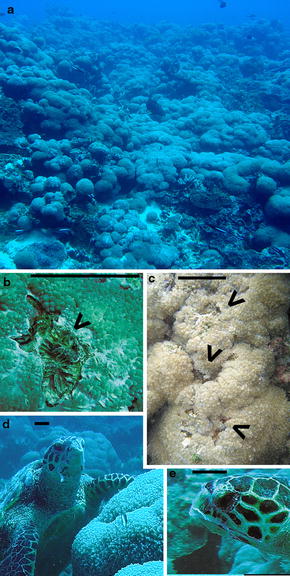


After the hours-long process, the female returns to the sea. imbricata normally contain around 140 eggs. They clear an area of debris and dig a nesting hole using their rear flippers, then lay clutches of eggs and cover them with sand. After mating, females drag their heavy bodies high onto the beach during the night. Indian Ocean populations, such as the Seychelles hawksbill population, mate from September to February. Mating season for Atlantic hawksbills usually spans April to November. The most significant nesting beaches are in Mexico, the Seychelles, Indonesia, and Australia. Hawksbills mate biannually in secluded lagoons off their nesting beaches in remote islands throughout their range. Males have more intense pigmentation than females, and a behavioural role of these differences is speculated. It is unknown if this is derived from the turtle's diet, which includes biofluorescent organisms like the hard coral Physogyra lichtensteini. The hawksbill sea turtle has been shown to be biofluorescent and is the first reptile recorded with this characteristic. In contrast, the green sea turtle and the leatherback turtle have a more symmetrical gait.ĭue to its consumption of venomous cnidarians, hawksbill sea turtle flesh can become toxic. The hawksbill appears to frequently employ its sturdy shell to insert its body into tight spaces in reefs.Ĭrawling with an alternating gait, hawksbill tracks left in the sand are asymmetrical. The turtle's carapace has been known to reach almost 1 m (3 ft) in length. imbricata's posterior scutes overlap in such a way as to give the rear margin of its carapace a serrated look, similar to the edge of a saw or a steak knife. While its carapace has five central scutes and four pairs of lateral scutes like several members of its family, E. One of the hawksbill's more easily distinguished characteristics is the pattern of thick scutes that make up its carapace. The hawksbill's forelimbs have two visible claws on each flipper.

Its elongated, tapered head ends in a beak-like mouth (from which its common name is derived), and its beak is more sharply pronounced and hooked than others. Several characteristics of the hawksbill sea turtle distinguish it from other sea turtle species. They are endangered because there nests are landfilled and people eat there eggs Because people use the shell to make jewelry and other things, the hawksbill turtle is endangered. Though they are sometimes seen in American waters, hawksbill turtles almost always nest in the warmer climates that run along the equator. The hawksbill pointy beak helps the turtle get food out of the tiny cracks and holes in which it searches. The hawksbill gets food from inside coral reefs, eating sponges, shrimp, squid, and other invertebrates. It has the most pointed beak among sea turtles, which is how it gets its name. It is smaller than the Australian flatback turtle: it is usually a little more than two feet long. It is mostly seen in shallow lagoons and coral reefs where the sea sponges it eats live. The Hawksbill Sea Turtle (Eretmochelys imbricata) is an endangered species of turtle. Eretmochelys imbricata bissa (Rüppell, 1835)Įretmochelys imbricata imbricata ( Linnaeus, 1766)Įretmochelys imbricata squamata junior synonym


 0 kommentar(er)
0 kommentar(er)
